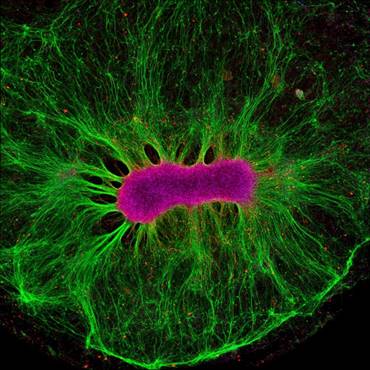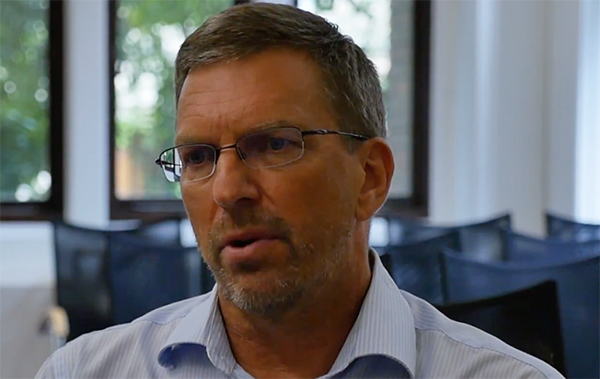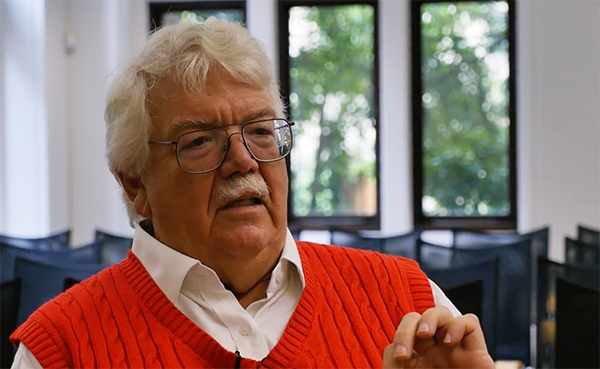Human Brain Organoids: the Science, the EthicsOxford Martin School, University of Oxford, 34 Broad Street, Oxford OX1 3BD 
Image Credit: Collin Edington and Iris Lee, Koch Institute MIT   On June 1, the International Neuroethics Society and the Wellcome Centre for Ethics and Humanities co-hosted a symposium on human brain organoids. Neuroscientists, clinicians, lawyers and philosophers gathered to hear lectures given by:
The lectures were followed by invigorating discussion and debate on the science and the ethics associated with this new technology. Here you will find a summary of the issues discussed, an overview video, and videos of the three lectures. The event was chaired by Hannah Maslen, University of Oxford, and is organized jointly by the Wellcome Centre for Ethics and Humanities at the University of Oxford and the International Neuroethics Society, with support from the European Dana Alliance for the Brain. About Human Brain OrganoidsHuman brain organoids are miniature 'brain structures' that can be generated from stem cells. These have the capacity to produce new, complex and developing neuronal tissue and have the potential to provide neuroscientists with models of parts of a functioning human brain for research. Transplanting a human brain organoid into the brain of a rat could provide more information. It could show how the organoid works in the context of a full brain. But brain organoids are limited by their lack of blood supply. Inside a rat's brain, the organoid might be able to use the rat's blood supply and grow larger. Either way, the result is a human/non-human chimera: a creature whose tissue is part human, part rat. Could that mean that the rat could acquire human characteristics? Human brain organoids might transform neuroscience. At a time when we so urgently need to understand the brain to help relieve vast amounts of human suffering, perfecting this approach might be a crucial part of that endeavor. But can the ethics and regulation keep pace with the science? SummaryBy Ian Stevens, Northern Arizona University At a meeting titled "Human Brain Organoids: the Science, the Ethics" an array of philosophy, neuroscience, and law scholars as well as clinicians gathered to explore the ethical concerns that have arisen from the development of human brain organoids (HBO). However, the goal of the symposium was also to look ahead, at what ethical challenges the scientific community must prepare themselves for as HBOs develop in sophistication and complexity. Speakers at this half-day event, organized by the International Neuroethics Society and the Wellcome Centre for Ethics and Humanities, were Dr. Madeline Lancaster at the MRC Laboratory of Molecular Biology, Professor Julian Savulescu of Oxford University, and Professor Hank Greely of Stanford University and the current President of the International Neuroethics Society. These speakers gave insightful talks on both the science and ethics of brain organoids. Dr. Lancaster lead the presentations by discussing the science behind HBOs. She began by describing the experimental need for these organoids by highlighting the fact that neurological disorders are poorly treated and understood. This is largely due to what Dr. Lancaster described as the 'clinical trial cliff' of neuroscience research. That is, while pharmaceutical remedies for neurological disorders like epilepsy and schizophrenia have been successful in numerous experimental conditions, their applications have failed clinically—some with deleterious consequences. Dr. Lancaster stressed that while we are studying brain diseases it is best to remind ourselves that we are studying the organ that is unique to our species, the mature human brain. Therefore, to account for the theoretical misstep of animal to human, numerous techniques to create brain organoids have been developed to provide a new model of study. However, this does not come without new scientific limitations and ethical concerns. Dr. Lancaster provided four major criteria to highlight and evaluate how brain organoids are not likely to be 'thinking' and how they ethically compare to other mouse, cancer, and transgenic animal models. These criteria consisted of the spatial organization, number and complexity of the neurons, the maturity of these neurons, and the stimulation of these neural tissues. However, in her summary she described how, beyond possible cell maturity and complexity, these HBOs do not satisfy these criteria and are not capable of 'thinking' as it is classically understood. This was exemplified by the fact that of neural numbers alone, and not organization, HBOs are only slightly larger than the brains of cockroaches. However, regardless of the scientific answer to if HBOs have a capacity for thinking, what emerged from her discussions was the ethical importance of the other research models using these same criteria. Mice, brain tumors, ex vivo brain tissue, and transgenic animals all satisfy one or all of these criteria, yet some contemporary scientific practices have still deemed it ethical to use them in research. Maybe this has something to do with our ability to relate to the 'human' nature of HBOs and feel an obligation to protect it. Regardless, Dr. Lancaster's final take-away took a biotechnological turn and discussed the regulation and ethical consideration of induced pluripotent stem cells (iPSCs) and human/non-human chimeras. In her final moments of presentation Dr. Lancaster highlighted the need for the ethical debate for both transgenic animal practices and legislative policies surrounding iPSCs. iPSCs are cells obtained from somatic cells in the body and programed to become pluripotent by transcription factors and thus can re-differentiate into HBOs.(1) These cells can be the basis for human cloning yet in Dr. Lancaster's experience regulatory committees may not be giving these cells enough oversight. This might be due to them not being embryonic stem cells. Secondly, to possibly show the ethical weight of future chimera concerns, she presents the audience with the striking image of a pig growing a human brain. So, while Dr. Lancaster started by discussing the brain organoid's potential ability to think, audiences were left with the ethical concerns that the next generation of neuroscientific models, if brain organoids do not prove the solution for the clinical trial cliff, could be chimeric brains. The next speaker highlighted these concerns as well, but from the perspective of a philosopher. Dr. Savulescu, a prominent philosopher at the University of Oxford, focused his presentation on the philosophical and ethical concerns of HBOs. He began his presentation by agreeing with Dr. Lancaster on the importance of advances in neuroscience for treatment by quoting that "every year you delay research curing a disease that kills 100,000 per year means you are responsible for the 100,000 deaths, even if you never see them." Yet with professional experience in the ethics of human/non-human chimeras that spans the last twenty years, he described HBOs as just the tip of the iceberg. He listed numerous examples of non-human chimeras that include combinations of tigers, lions, goats and sheep, to demonstrate science's ability to make non-human/human chimeras. Refocusing on the philosophy, Dr. Savulescu articulated that in order to tackle the ethical status of these organisms and organoids we need to answer the ontological question of moral significance. That is, what things give an organism their right to be considered a moral agent? However, where choosing such a characteristic, and then answering to what degree this characteristic is necessary for moral status (sentience, agency, rationality) is a highly debated topic. Then there is an epistemological question: how should we determine whether this property is present in an HBO? This led him to discuss three major ethical recommendations in accessing the moral status of HBOs and chimeras that all fell under the heading of "Ethics first! Science second." These included the importance for moral generosity and granting the highest level of moral status to unknown organisms; not assuming that [neural] structure does not grant higher functions; and evaluating moral status before experimentation—thus ethics before science. These recommendations all painted a cautionary ethical picture of how to treat HBOs as they develop. The second thread of conversation in the presentation, Dr. Savulescu focused on the question of consciousness. While he concluded that there are no concerns for consciousness now in HBOs, the need for future concern is pressing. "For all we know," he said with a pause, "it could be a living hell [being a HBO]". Thus, the need for understanding where on the spectrum of consciousness both chimeras and HBOs are, is vital. He drew and analogy to how fetuses don't gain consciousness until 20 weeks and how synthetic embryos escape this ethical guideline. However, these practices may be one day unjustified when they develop, like HBOs could, into resembling a full fledge human embryo. Still, with all his justifications Dr. Savulescu reached a humbling conclusion. He pointed out that while we might be debating if HBOs have consciousness, this criterion may not even be enough to resist researching on them, since a clear majority of animals that are tested on have at least one form of consciousness. While these are important bioethical concerns, the next speaker took a more neuro-centric focus. Dr. Greely brought the conversation back to what he felt were the brain issues of HBOs and away from the ethical concerns of chimeras raised by Dr. Savulescu. Like Dr. Lancaster he described the dilemma driving the use of HBOs is the scientific community's desire to study human brains and resolve the toils of mental illness. Dr. Greely talked about the failure of another test model, namely the human subject. He articulated how humans are bad lab animals with lawyers, informed consent, and long gestation time, thus the desire to develop the HBO. Yet in a contradicting fashion, as we create models that are more analogous to humans, the more pressing the ethics surrounding these models become. Similarly, then all the problems in creating a moral status for HBOs gets more complicated. Dr. Greely also pointed to his worries about ex vivo tissue of autopsies, other extracted brain tissues from surgery because their significance in the current neuroscientific research. He cited research that demonstrates the recorded electrical activity of a dead pig's brain up to 36 hours.(2) These findings point to that fact our scientific concerns about HBOs today are likely inflated and that HBOs are far from what brings up concerns, today. The remainder of Dr. Greely's presentation focused on what he feels are the pressing moral problems of the HBOs. He takes a position, like Dr. Savulescu, in asking what the well-fare of these entities should be? As they might not need consciousness to be treated properly. Some might cringe at someone pulling the legs off a cockroach even when they are said not to have consciousness in a full and rich sense. Therefore, why focus on if HBOs can 'feel'? The second question focused on the humanization of HBOs: is the problem of HBOs that we are making them more human? This led him to his third and final question, is the problem that we are actually making them more intelligent and self-conscious? This question posits more depth to the fact that while science is not there yet, it might one day be faced with an intelligence that is not of our own (i.e. the intelligence of an octopus or computer). This, as Dr. Greely points out, is a question that over the next five to ten years neuroethics will need to resolve. He recommended that the ethics should start now by better understanding the science as it could provide the answers that ethics will need to fill in. Therefore, in this field and the iPSC regulators, it is best to prepare for the regulation (and who will provide the regulations) for these potent biotechnologies. However, in a humbling remark yet again, Dr. Greely emphasized that there is no guarantee that HBOs will save the research setting from the clinical trial cliffs as it has been forecasted to do. These presentations gave their audiences a perplexing situation. Regardless, scholars and the public were presented with the contemporary reality that no matter the question that emerges over the next decade of neuroscience or biotechnological research, answers will be found by the collaboration between scientists and philosophers. So that as our problems to relieve the world of neurological diseases become more complicated, so too will the array of scholars working together to solve them. References
Lectures
|



